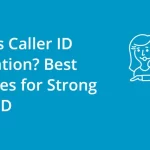In recent years, the problem of caller ID spoofing has become increasingly prevalent. Scammers are using technology to trick consumers into thinking that calls are coming from legitimate sources, leading to an increase in spam risk caller ID. In this article, we will explore what caller ID spam is, how to get rid of spam caller ID, and how to set up caller ID and spam.
What is Caller ID Spam?
Caller ID spam, also known as caller ID spoofing, is a technique used by scammers to manipulate the caller ID information that appears on your phone. This allows them to make it look like their calls are coming from a trusted source, such as a bank or government agency, when in reality they are not. This is a form of social engineering that aims to trick consumers into revealing personal information or making payments to fraudsters.
The problem of no caller ID spam calls has become especially prevalent in recent years as scammers have become more sophisticated in their techniques. For example, some scammers use automated systems to make calls, which can dial thousands of numbers at once. This means that consumers are more likely to receive calls from potential spam caller ID numbers.
Check Number for Spam: How to Get Rid of Spam Caller ID
So, how can you get rid of spam caller ID? The first step is to be aware of the problem and to understand how it works. If you receive a call from a number that you do not recognize, it is important to be cautious. Do not reveal any personal information, such as your social security number or credit card details, unless you are certain that the call is legitimate.
One way to check number for spam is to use a caller ID checker. There are several free and paid services available online that can help you identify potential spam caller ID numbers. These services use databases of known scam numbers to check whether a number is likely to be a scammer.
Another way to get rid of spam caller ID is to block the number. Most smartphones have a built-in feature that allows you to block calls from specific numbers. If you receive a call from a potential spam caller ID number, you can simply block the number to prevent any further calls.
Setting up Caller ID and Spam
To protect yourself from caller ID spam, it is important to set up caller ID and spam features on your phone. Most smartphones have built-in features that allow you to block calls from unknown numbers or numbers that have been flagged as potential spam caller ID. You can also set up caller ID to display the name and number of the person calling you.
To set up caller ID and spam features on your phone, go to your phone settings and look for the option to manage your phone’s call settings. From there, you should be able to enable or disable caller ID and spam features, as well as block specific numbers.
In addition to setting up these features on your phone, it is also important to be vigilant and to exercise caution when receiving calls from unknown numbers. If you receive a call from a potential spam caller ID number, do not reveal any personal information and consider blocking the number to prevent any further calls.
Caller ID spoofing is a growing problem that can lead to an increase in spam risk caller ID. Scammers are using technology to trick consumers into revealing personal information or making payments to fraudsters. To protect yourself from caller ID spam, it is important to be aware of the problem and to set up caller ID and spam features on your phone. By following these steps, you can reduce your risk of falling victim to caller ID spoofing scams.
A telephone validation service is a tool that can be used to verify the authenticity of a phone number. It works by checking whether a phone number is valid and whether it is associated with a real person or business. This service can be particularly useful in the context of caller ID spoofing.



